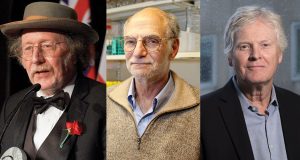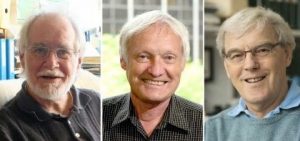Over past week the Nobel committee has been announcing their selections for this year’s prizes. This year it seems as if trios are popular because each of the prizes for science was awarded to a trio of researchers.
The award for medicine / physiology was the first to be announced on Monday. The winners were Jeffery C. Hall and Michael Rosbash, who worked together at Brandeis University in Massachusetts along with Michael W. Young at Rockefeller University in New York. See Picture below.

The Three scientists were honoured for their research into the biological rhythms built into living creatures, a phenomenon known as the Circadian clock, the 24 hour day-night cycle caused by the rotation of the Earth.
The two teams conducted their research using fruit flies, a species that has been center stage in biological studies for over a century now. What they discovered was that the mechanism of the clock consisted of a network of genes and proteins that time the release of hormones turning on then turn off sleep, raise and low body’s temperature and blood pressure while regulating other body processes. Occasional disruptions in this genetic rhythm results in the familiar ‘Jet-Lag’ while prolonged disruptions can result in a number of serious health problems.
Before I move on I would to mention that much of the original work on circadian clocks was carried out by two scientists named Seymour Benzer and Ronald Konopka. It was these two men who discovered the ‘Period’ gene that initiates the entire process. Benzer and Konopka are ineligible to share in the prize however as they are both deceased. Alfred Nobel’s will specifically states that only living scientists can receive the award and this is not the first time that a scientist worthy of the honour has died before the committee saw fit to select them.
On Tuesday it was the Physics prize that was announced and I was very pleased to learn that it had been shared by Rainer Weiss of the Massachusetts Institute of Technology (MIT) along with Kip Thorne and Barry Barish of the California Institute of Technology (Caltech not CIT). See picture below.

The work for which these scientists won the prize was the detection and measurement of Gravitational waves, a phenomenon predicted by Albert Einstein in his Theory of General Relativity almost exactly a century before they were finally detected.
Professors Weiss, Thorne and Barish are the principle designers and leaders of the Laser Gravity Wave Observatory (LIGO) project. I have written posts about the LIGO project earlier (14Jun2017) but simply put the LIGO project consists of two, four kilometer long L shaped laser detectors, one in Hanford Washington the other in Livingston Louisiana.
By comparing the laser beams traveling up and down the two arms of the L the detector is capable of measuring tiny distortions in the fabric of space-time itself. Using the two detectors allows the direction of signals source to be estimated and now that a third detector in Italy (VIRGO) has come on line the accuracy of the direction measurement will increase.
Detecting gravity waves is a completely new way of looking at the Universe and every time science has succeeded in doing that we’ve discovered thousands of new wonders. We can only hope that the study of gravity waves will prove to be as fruitful.
On Wednesday it was the Chemistry prize that was announced. The recipients were Jacques Dubochet of Lausanne University in Switzerland; Joachim Frank of Columbia University in New York along with Richard Henderson of Cambridge University’s Labouratory of Molecular Biology. It’s worth noting that Professor Henderson is the 15th Nobel laureate from the Lab (Not 15 Nobel laureates at Cambridge, 15 at just that lab at Cambridge!!!). See picture below.

The work these three men carried out was the development of a series of techniques that have enabled scientists to better image complex organic molecules and structures with electron microscopes. Electron microscopes are similar to the microscopes you used back in High School but because the wavelength of an electron is so much smaller than that of visible light an electron microscope can magnify an image thousands of times more. I’ve had several occasions in my career to use electron microscopes to study electronics and they are wonderful instruments that can provide so much useful data.
Electron microscopes have problems when used to study living tissue however. First of all the electron beam must be in a vacuum, a condition that is not only lethal but can also cause the water in the cells to evaporate explosively, and remember we are composed of 70% water. Also the beam of electrons itself can be powerful enough to physically alter the specimen being studied.
Professor Henderson developed a technique for replacing the water in organic structures with a sugar cocktail that could withstand the vacuum. Professor Dubochet took a different tack, creating a process that quick froze the specimens so that the water in them did not crystallize. This process is called Cryo-electron-microscopy. Finally Professor Frank used computer algorithms to increase the precision of the data allowing scientists to learn even more from their instruments. An example of just how detailed the images provided by an electronic microscope have become the picture below shows a protein molecule.

The discoveries made by this year’s Nobel laureates have brought great advances to human knowledge. In a world filled with an almost daily barrage of bad news maybe we should think of a way to honour our scientists more than three days a year!
